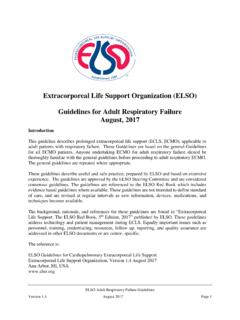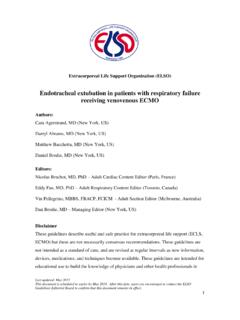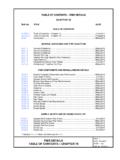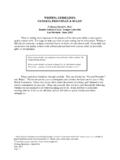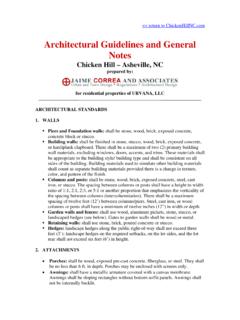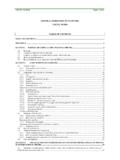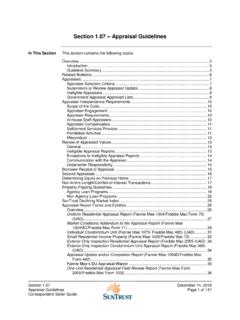Transcription of ELSO Guidelines General All ECLS Version1.1
1 ELSO General Guidelines Version August 2017 Page 1 Extracorporeal Life Support Organization (ELSO) General Guidelines for all ECLS Cases August, 2017 Introduction This guideline describes prolonged extracorporeal life support (ECLS, ECMO), applicable to patients of any age with cardiac or respiratory failure. Related Guidelines with more specific discussion for categories of patients follow the same outline. These Guidelines describe useful and safe practice, prepared by ELSO and based on extensive experience. The Guidelines are approved by the ELSO Steering Committee and are considered consensus Guidelines . The Guidelines are referenced to the ELSO Red Book which includes evidence based Guidelines where available. These Guidelines are not intended to define standard of care, and are revised at regular intervals as new information, devices, medications, and techniques become available.
2 The background, rationale, and references for these Guidelines are found in Extracorporeal Life Support: The ELSO Red Book, 5th Edition, 2017 published by ELSO. These Guidelines address technology and patient management during ECLS. Equally important issues such as personnel, training, credentialing, resources, follow up, reporting, and quality assurance are addressed in other ELSO documents or are center- specific. The reference is: ELSO Guidelines for Cardiopulmonary Extracorporeal Life Support Extracorporeal Life Support Organization, Version August 2017 Ann Arbor, MI, USA ELSO General Guidelines Version August 2017 Page 2 Contents I. Patient Condition (Chapters 11, 19, 29, 37, 44) .. 4 A. Indications .. 4 B. Contraindications .. 4 C. Specific patient considerations .. 4 II. Extracorporeal Circuit (Chapters 4, 5) .. 4 A. Criteria for selecting circuit components .. 4 1. Blood flow for cardiac support.
3 4 2. Blood flow and gas exchange for respiratory failure (VA or VV) .. 5 B. Circuit components .. 5 C. Pump .. 5 1. Inlet (suction) pressure .. 5 2. Outlet pressure .. 5 3. Power failure .. 6 4. Hemolysis .. 6 D. Membrane lung (often called the Oxygenator) (Chapters 4, 5) .. 6 E. Sweep gas .. 7 F. Priming the c ircuit .. 7 G. Heat exchanger .. 8 H. Monitors .. 8 I. Alarms .. 9 J. Blood tubing .. 9 K. Elective vs. emergency circuits .. 9 III. Vascular Access (Chapters 4, 12, 20, 30, 38, 47) .. 9 A. The modes of vascular access are .. 10 B. Cannulas .. 10 C. Cannulation .. 10 1. 10 2. Cannulation technique .. 10 3. Management of the distal vessels .. 11 ELSO General Guidelines Version August 2017 Page 3 4. Adding or changing 12 IV. Management during ECLS (Chapters 4, 5, 14, 22, 32, 40, 49) .. 12 A. Circuit related .. 12 1. Blood flow .. 12 2. Oxygenation .. 12 3. CO2 clearance .. 13 4. Anticoagulation (Chapters 6, 7, 8) .. 13 5.
4 Circuit monitors, alarms, and safety (Chapters 4, 5) .. 15 6. Component and circuit changes .. 17 7. Traveling (Chapter 66) .. 17 B. Patient related management (Chapters 4, 5, 14, 22, 32, 40, 49) .. 18 1 Hemodynamics .. 18 2. 18 3. 20 4. Blood volume, flui d balance and hematocrit (Chapters 8, 41, 62) .. 21 5. Temperature .. 21 6. Renal and nutrition management (Chapters 4, 41, 62) .. 22 7. Infection and antibiotics .. 22 8. Positioning .. 22 9. Bleeding (Chapter 7) .. 22 10. Procedures (Chapter 6) .. 24 V. Weaning, Trials off, Discontinuing ECLS for Futility .. 25 (Chapters 4, 16, 24, 34, 42, 51) .. 25 A. Weaning .. 25 B. Trial off .. 25 C. Decannulation .. 26 D. Stopping support for futility .. 26 VI. Patient and Disease Specific Protocols .. 26 VII. Expected Results (per pa tient and disease category) .. 26 ELSO General Guidelines Version August 2017 Page 4 ECLS is the use of mechanical devices to temporarily (days to months) support heart or lung function (partially or totally) during cardiopulmonary failure, leading to organ recovery or replacement.
5 Supporting literature, evidence, and rationale for these Guidelines is in the ELSO Red Book. In this document references to specific chapters in the 5th E dition Red Book are identified Chapter x. I. Patient Condition (Chapters 11, 19, 29, 37, 44) A. Indications The primary indication for ECLS is acute severe heart or lung failure with high mortality risk despite optimal conventional therapy. ECLS is considered at 50% mortality risk, ECLS is indicated in most circumstances at 80% mortality risk. Severity of illness and mortality risk is measured as precisely as possible using measurements for the appropriate age group and organ failure. See patient- specific protocols for details. Other elective indications are to support heart and or lung function during temporary nonfunction, such as extensive bronchoalveolar lavage, operations on the trachea or mediastinum, or coronary artery occlusion during procedures.
6 B. Contraindications Most contraindications are relative, balancing the risks of the procedure (including the risk of using valuable resources which could be used for others) vs. the potential benefits. The relative cont raindications are: 1) conditions incompatible with normal life if the patient recovers; 2) preexisting conditions which affect the quality of life (CNS status, end stage malignancy, risk of systemic bleeding with anticoagulation); 3) age and size of patient; 4) futility: patient s who are too sick, have been on conventional therapy too long, or have a fatal diagnosis. See patient-specific protocols for details. C. Specific patient considerations See patient-specific protocols II. Extracorporeal Circuit (Chapters 4, 5) A. Criteria for selecting circuit components The circuit is planned to be capable of total support for the patient involved, unless the intent is specifically partial support ( CO2 removal for asthma) 1.
7 Blood flow for cardiac support Access is always venoarterial. The circuit components are selected to support blood flow 3 L/m2/min (neonates 100 cc/kg/min; pediatrics 80 cc/kg/min; adults 60 ELSO General Guidelines Version August 2017 Page 5 cc/kg/min.) The best measure of adequate systemic perfusion is venous saturation greater than 70%. Achieving a desired flow is determined by vascular access, drainage tubing resistance, and pump properties. 2. Blood flow and gas exchange for respiratory failure (VA or VV) The membrane lung and blood flow should be capable of oxygen delivery and CO2 removal at least equal to the normal metabolism of the patient ( an oxygen delivery of 6 cc/kg/min for neonates; children 4-5 cc/kg/min; adults 3 cc/kg/min), This will usually equate to VV blood flows of 120 ml/kg/min for neonates down to 60-80 ml/kg/min for adults. Oxygen delivery capability is determined by blood flow, hemoglobin concentration, inlet hemoglobin saturation, and membrane lung properties.
8 Carbon dioxide removal always exceeds oxygen delivery when the circuit is planned for full support. If the circuit is planned for CO2 removal only, access can be venoarterial, venovenous, or arteriovenous. Typical blood flow is approximately 10-25% of cardiac output, which is sufficient to remove the CO2 produced by metabolism (3-6 cc/Kg/min). CO2 removal is determined by the blood flow and the sweep gas rate, the inlet PCO2 and the membrane lung properties. B. Circuit components The basic circuit includes a blood pump, a membrane lung, and conduit tubing. Depending on the application, additional components may include a heat exchanger, monitors, and alarms. C. Pump The pump should be able to provide full blood flow for the patient, as defined above. Any pump which meets the specifications can be used (modified roller with inlet pressure cont rol; centrifugal or axial rotary pump with inlet pressure control; peristaltic pump).
9 1. Inlet (suction) pressure With the inlet line occluded the suction pressure should not exceed minus 300 mmHg. The inlet pressure can be very low (minus 300 mmHg) when the venous drainage is occluded (chattering) which causes hemolysis. Inlet pressure in excess of minus 300 mmHg can be avoided by inherent pump design or through a servocontrolled pressure sensor on the pump inlet side. 2. Outlet pressure With the outlet line occluded the outlet pressure should not exceed 400 mm/Hg (inherent in the pump design or by a servocontrolled system). ELSO General Guidelines Version August 2017 Page 6 3. Power failure The pump should have a battery capable of at least one-hour operation, and a system to hand crank the pump in the event of power failure. The pump and circuit should have a mechanism to alarm for or prevent reverse flow (arterial to venous in the VA mode) if the power fails.
10 4. Hemolysis The plasma hemoglobin should be less than 10 mg/dl under most conditions. If the plasma hemoglobin exceeds 50 mg /dl, the cause should be investigated. D. Membrane lung ( often called the Oxygenator) (Chapters 4, 5) The gas exchange material in membr ane lungs may be solid silicone rubber, a microporous hollow-fibre (polypropylene for example), or a solid hollow-fibre membrane (PMP, polymethyl pentene for example). Membrane surface area and mixing in the blood path determine the maximum oxygenation capacity (the rated flow). When used for total support, the membrane lung should provide full O2 and CO2 exchange for the patient as defined in The gas exchange capability of a specific membrane lung is described as rated flow or maximal oxygen delivery. These are two ways of describing the amount of desaturated (75%) blood that can be nearly fully saturated (95%) per minute Rated flow is the flow rate at which venous blood (saturation 75%, Hb 12 mg%) will be fully saturated (95%) at the outlet of the membrane lung.

